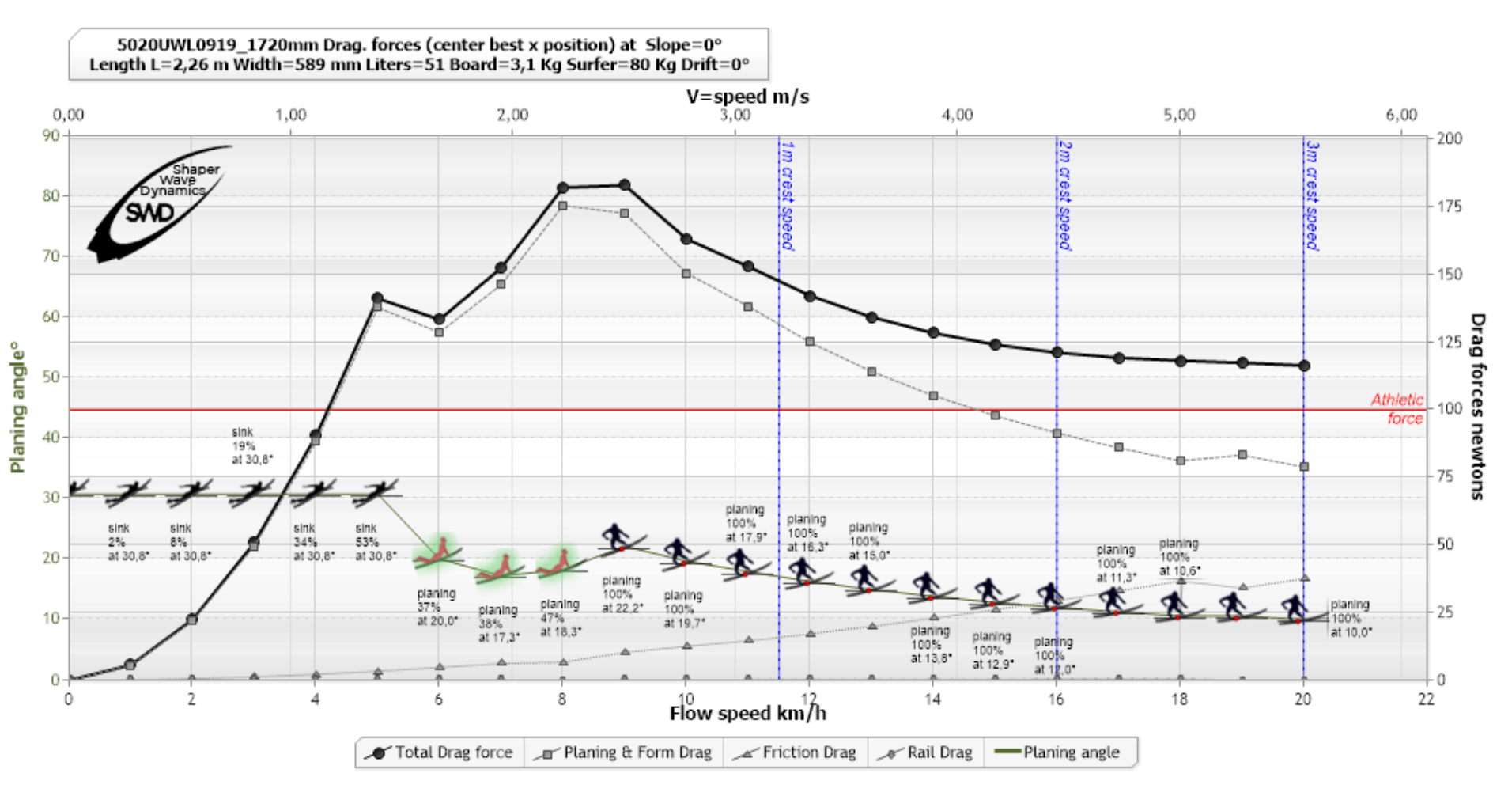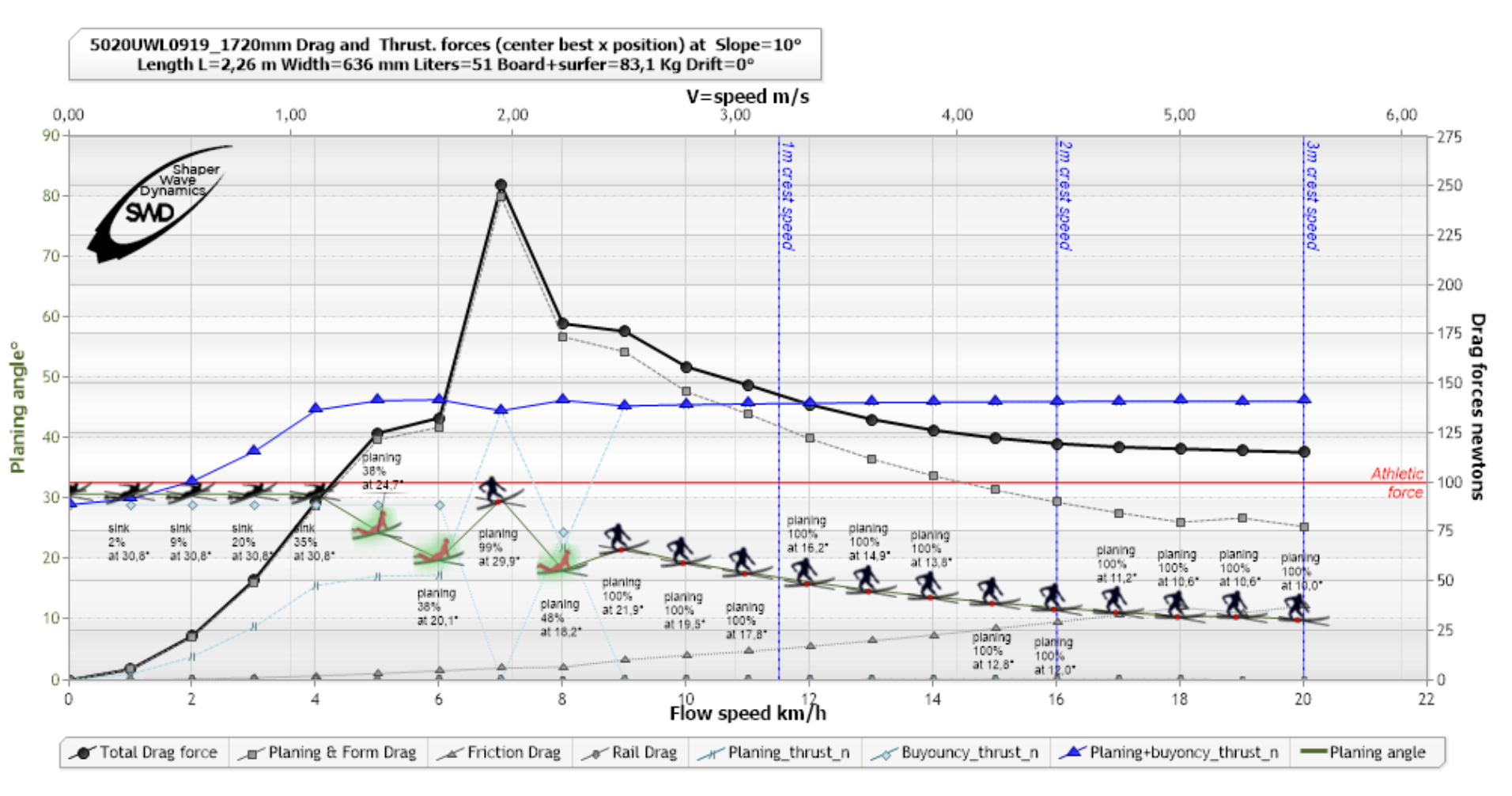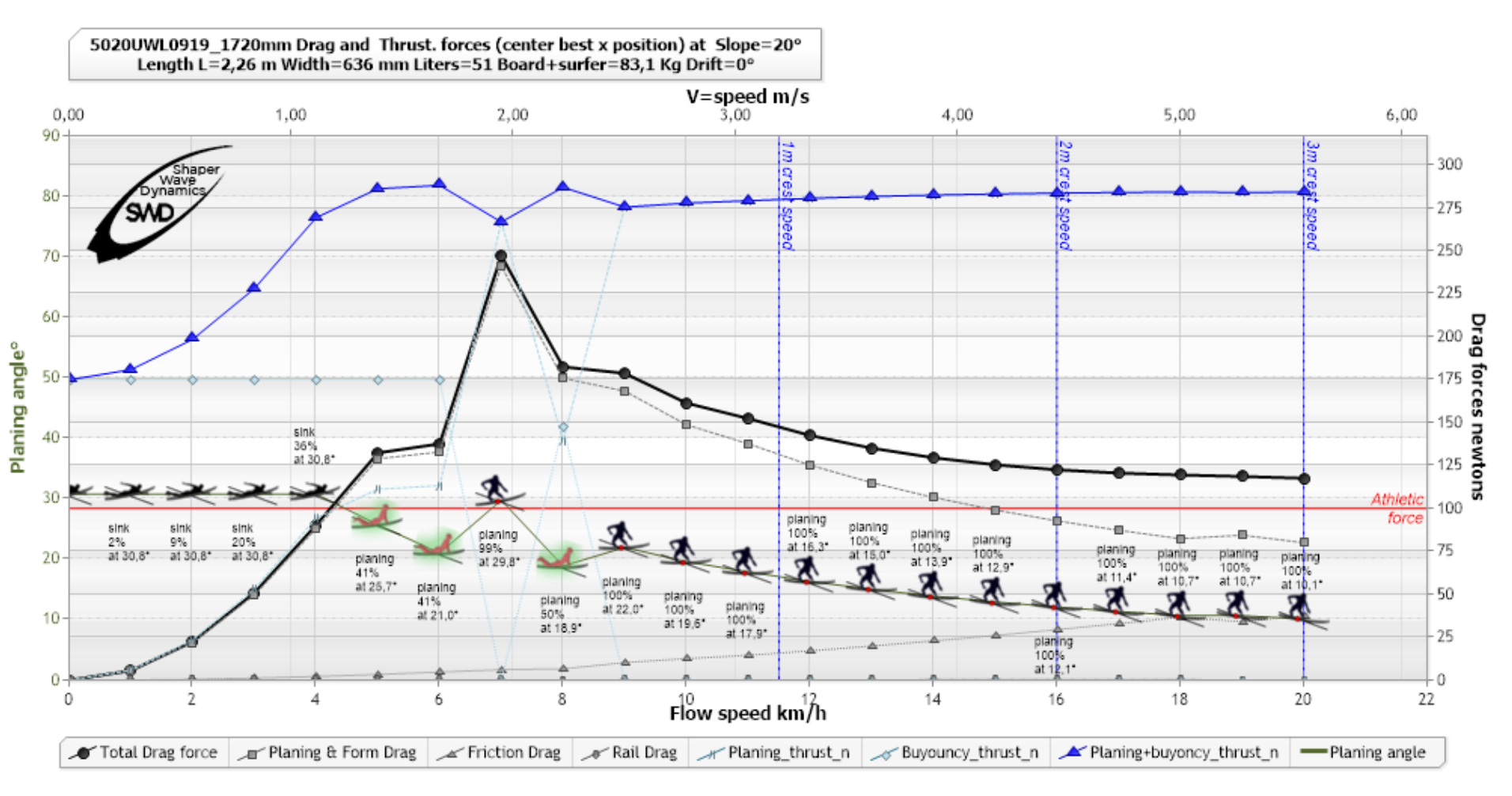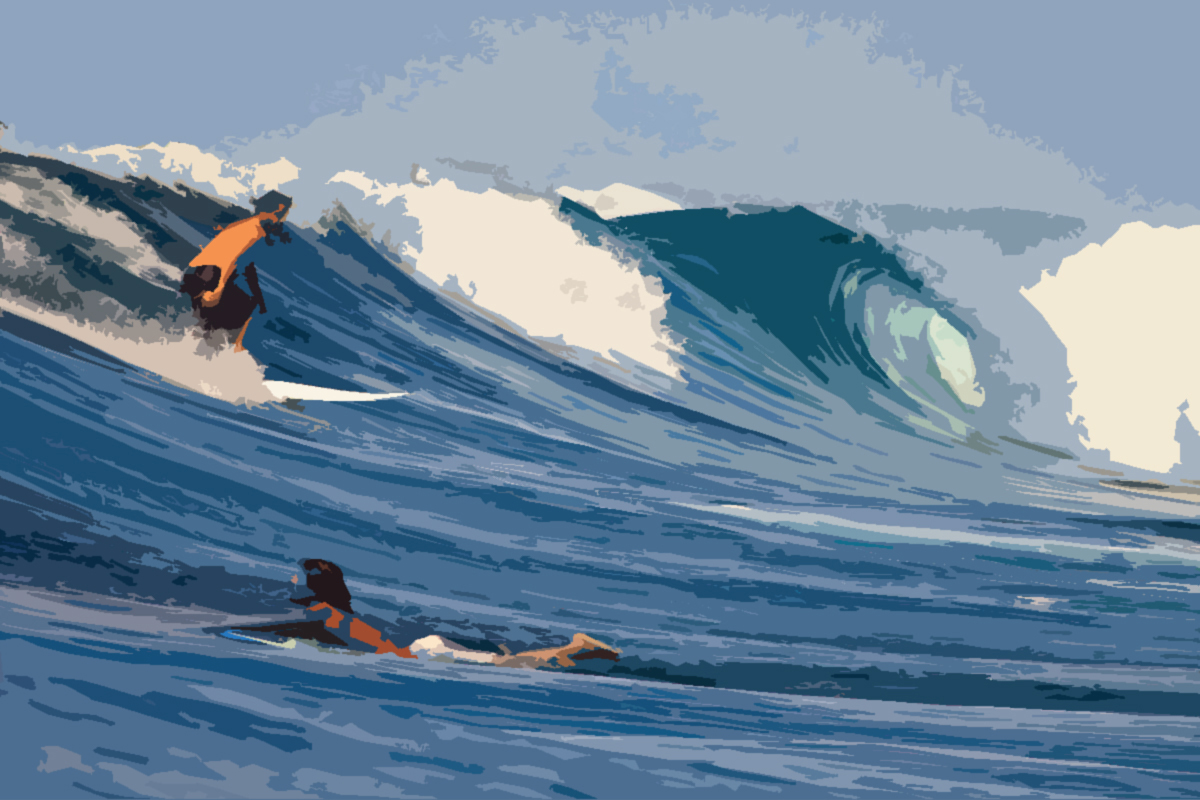 Surfing is instinct, the hydrodynamics and physics of surfing are too complex to comprehend! And if it was only a defeatist prejudice? What if learning the hydrodynamic basics of surfing physics was simply and naturally the best way to sharpen the surfer's and shaper's instincts?
Surfing is instinct, the hydrodynamics and physics of surfing are too complex to comprehend! And if it was only a defeatist prejudice? What if learning the hydrodynamic basics of surfing physics was simply and naturally the best way to sharpen the surfer's and shaper's instincts?
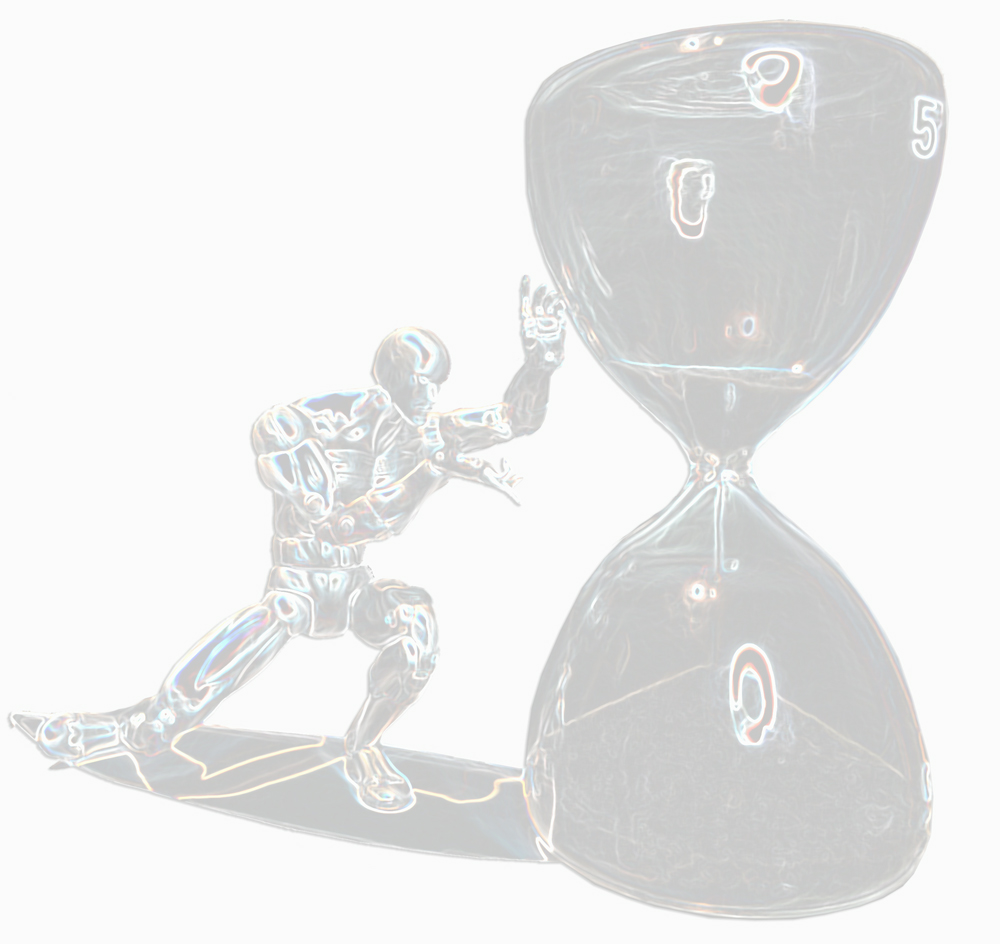
Knowing the hydrodynamic forces acting on a surfboard nevertheless makes it possible, for example, to objectively and instantly compare the resistance to forward movement of two boards, for a given surfer. This can save a lot of time and energy for surfers and shapers!
Understanding the physics of surfing is like watching a good movie. A masterpiece, with many actors whose role we understand, discreet but essential, only after having seen the film several times. We discover each time a new angle of view that nourishes our perception. We leave the film with the feeling of having learned certain things, but that so many others have escaped us, and that is why we want to see it again. This endless film of surfing is a trilogy integrating: movement, the geometry of a space distorting time, and forces. The whole thing propels the viewer into a dimension that will inhabit them all their life: the wave.

Silver surfer
“I made him into a receptacle of the ambient energies of the universe “ Says Galacticus, “I created for him a Wondrous Board which obeys his every thought” (Warshow, 2005)
The forces of surfing are hydrodynamic and hydrostatic. The surf forces depend on the position of the surfer, which modifies the angle of attack, and the trajectory of the turn. The volume of the board, the wetted surface, the slope of the wave, the weight, the speed..., are also factors that play decisive roles in the performance of your surfboard.
The notion of natural instinct offers those who overestimate their gifts and underestimate their intellectual abilities the perfect alibi for cultivating their ignorance. It is therefore frequent that the complexity of a rational approach to the physics of surfing discourages those who lack the tools to approach it. (see: surf hydrodynamics)
Encouraged by a certain vision of surfing culture, I too sailed by relying on my intuition. But even after several years of observing and experimenting, I was still unable to understand certain counter-intuitive phenomena, such as the intensity of the forces on a drift profile, depending on the speed and the angle of incidence. The surfer quickly learns that the geometric science of an alignment is the best way to locate the position of a shoal. When things get more serious, like transatlantics under sail, we study ship theory, meteorology, and sail trim to put the odds on our side. We then discover the treasures of aerodynamics and hydrodynamics which lift the veil on the invisible world of fluid mechanics. If the school did not know how to find the way of our capacities, the ingenuity of the naval architecture, reconciles us with the pleasure of the study.
Intuition is of course vital, it inspires our reasoning, but if a rational analysis does not protect us in return, from the pitfalls of certain intuitive shortcuts, we do not evolve. The duality intuition <=> reflection, is a balance:
- Abandon your intuition and you become a logical machine unable to live the emotion of the present
- Abandon scientific learning and you establish the obscurantism of medieval beliefs
- Scientifically verify what your intuition inspires in you and you will hold the engine of evolution in your hands.
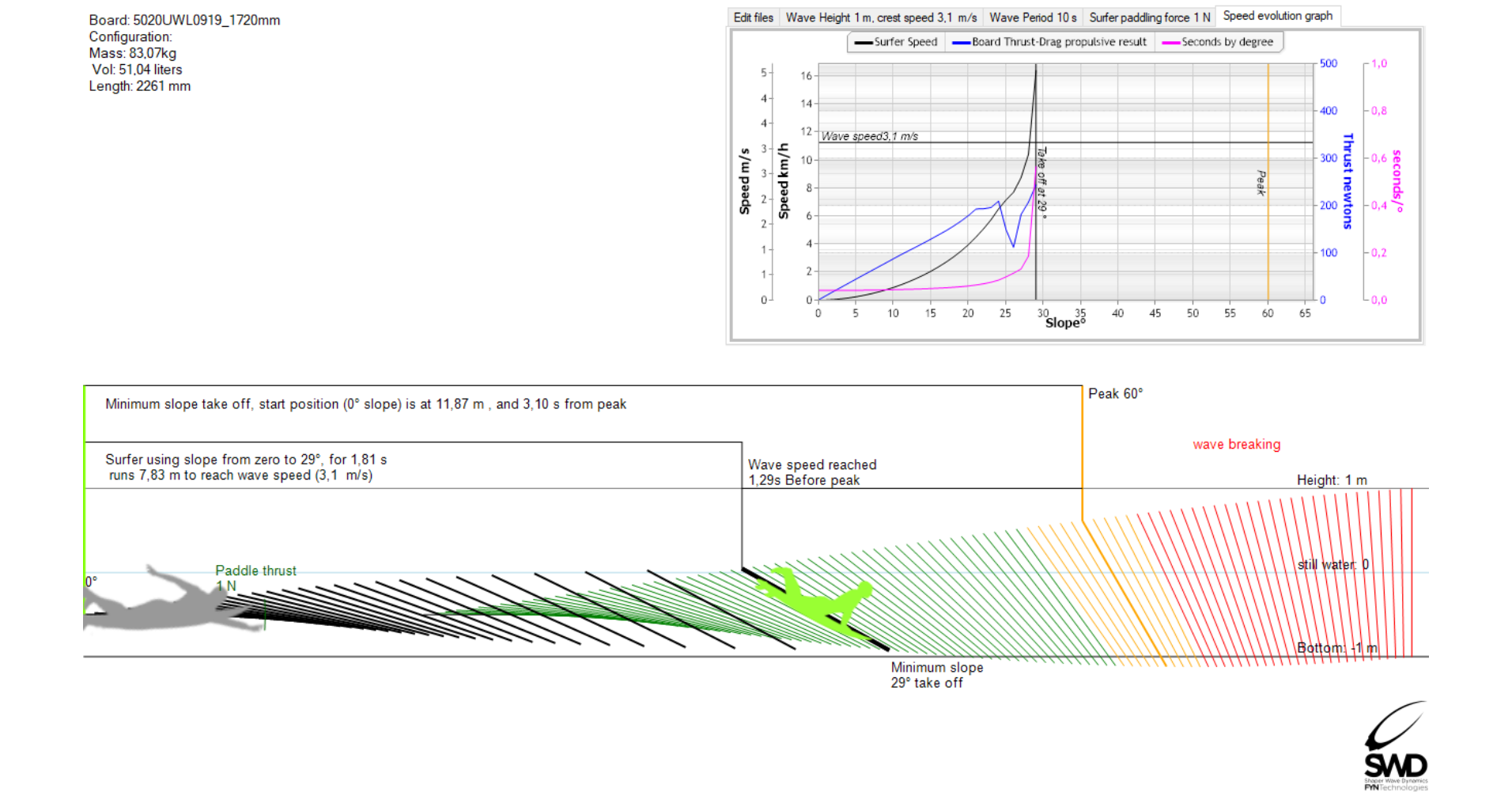
The classic mistake, which we have all made at least once, is to confuse instinct with taking a chance: instinct is built from observations and validations of hypotheses that we keep in mind. While the pifometer has no memory, it goes around in circles in a jar. "Taking a chance" is a nice guy, we have a good laugh with him, but are we going to entrust him with the design of our next board?
Let's take the concrete example of the influence of the weight of the surfer on the sizing of a board: The functioning of a board varies greatly depending on the weight of the surfer. Selecting a board for a beginner according to its weight, does not pose any particular difficulty, it is enough that the volume is sufficient to float. But adjusting the dimensions and volume of a board so that it is optimal is much more complex. The shaper must adapt the board according to the surfer, as much as according to the waves. Knowing how the planing will evolve by modifying the volume, and the length of a board, if the surfer is 5 kg more or less, is a daily problem for the shaper and the surfer. How to solve this problem? Here are 2 solutions:
Solution 1: "take a chance" recipe: Increase or decrease the size of the board, just in length, or just in width, or both, then tweak the volume a little, more in front or behind, or the opposite. By following data grids, taken from a catalog of a well-known brand, and mixing them with a board that had worked well according to a good friend who surfs really well, but which weighs ten kilos less. If we opt for this solution, with a little luck, we will find some satisfied surfers, because even a stopped clock gives the right time, twice a day. Make no mistake about it, under this salesman's speech, hides at best, a habit that is never questioned, and at worst, an interest in surfing limited to its financial aspect. In both cases, this recipe makes us go around in circles without progress.
Solution 2: Record the theoretical performance of all the boards you shape and establish a knowledge base of the factors generating the desired performance.Designing a good surfboard takes more than genius: A method. The solution to the correct sizing of the board lies in a minimum of hydrodynamic study. Humble surfer, village surfshop salesman, avid shaper artist, sailor, or naval architect, this example of a surfboard's drag graph needn't scare you: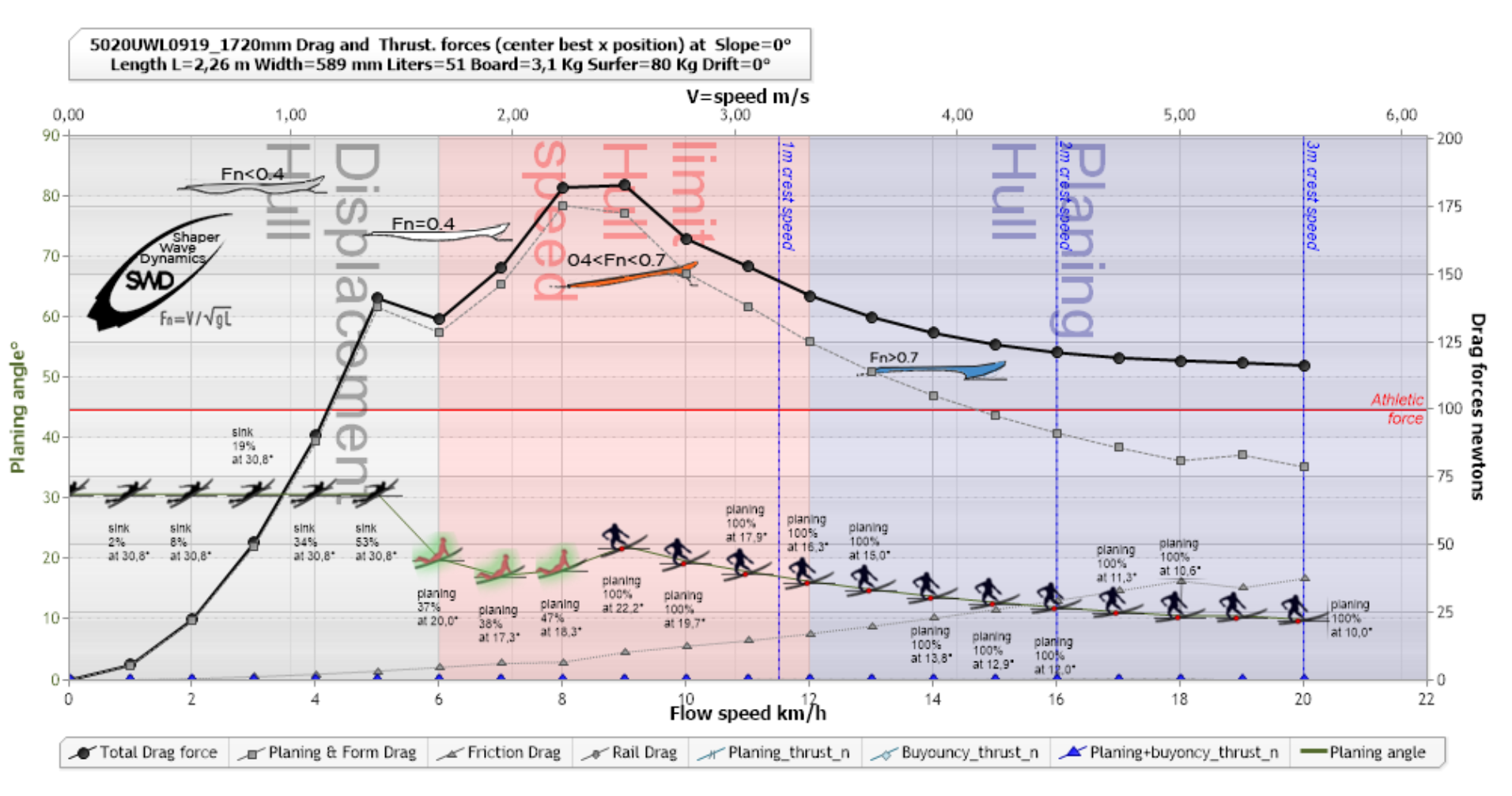
Hydrodynamic analysis curve as a function of speeds (Software ShaperWaveDynamics)
If you browse the pages of this site dedicated to the hydrodynamics of surfing, according to your curiosity as a surfer, this type of graph will no longer hold any secrets for you, you will see the qualities and arguments of a board in a given wave. Better, you can explain them. We can, for example, from the drag curves and propulsive forces of a surfboard, analyze its take off abilities (see surf take off physics). We can also analyze board maneuverability (see surf maneuverability) for a given surfer, board and wave.
Shapers like, Blake, Simmons or greenougth..., have made surfing progress. Calling them surfing geniuses is very respectful, but it frustrates any attempt to understand their work. These shapers were not mystical geniuses, but simple surfers passionate enough to study and methodically apply basic hydrodynamic principles. This is how they advanced surfing as we know it today. Their strength is ordinary and common to everyone: it is curiosity and memory! The Wrights brothers patiently memorized in notebooks, for months, the data and forces measured, on wing models experimented with the first wind tunnel in history, tinkered with in their small workshop. Measuring, memorizing, comparing and discovering the parameters of efficiency is the method at the origin of aero and hydrodynamics. Calling these men geniuses hides the most precious part of what they are. They are simple manufacturers of bicycles, who discover, thanks to their method, how to make them fly.
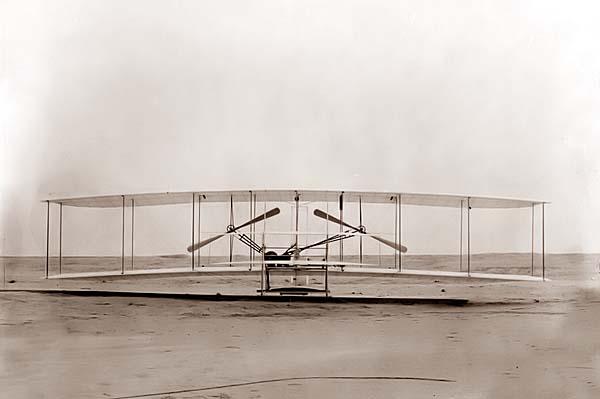
Wright Brothers 1904 Flying Bike: An Engine, Wings, Propellers...and a Method!
Surf professionals are curious sailors, they observe and like to understand the physics of surf and waves. The shaper is like the naval architect, under the obligation to understand why the navigator obtains good or bad performance. Both cases interest him as much in order to progress. When a board is perfect, in terms of stability, maneuverability and acceleration capacity, according to the feedback from an 80 kg surfer, the professional must quantify the real advantages of this board for this surfer. The stability, and the hydrodynamic drag of a given board, depending on the weight of the surfers, are two major qualifiers of the functioning of a board, which can inform the shaper about the effectiveness of a board. We will discover later some examples of applications of the hydrodynamics of surfing and their advantages for the shaper...
Definitions and examples of hydrodynamic application of surfing::
Measurements normalization: To simplify the comparison between boards, it is easier to speak in normalized dimensions: the normalized position of the tail is zero, and the normalized position of the nose is 1. position 0.5 is in the center of the board. We go from the normalized length to the actual length by simply multiplying the normalized length by the length of the board. the standardized dimensions, have no unit, finished the inch and the meters or the inches! Hydrodynamicians like to simplify their lives, so they speak in normalized dimensions.
Relative flow and attack angle:For the hydrodynamicist, the flow, its speed and its direction, are always relative flows, that is to say that we always consider that the surfer is the reference and that it is the flow that comes towards him. A surfer pulled at 40 km/h receives a relative flow of 40 km/h. The planing attack angle is the angle at which this relative flow comes into contact with the board. (see: surf relative flow and planing attack angle f)
Drift angle: The angle formed between the longitudinal axis of a board (or a boat) and the direction of the relative flow is the angle of drift. (see drift angle surf)
Diagram of surf positions: Here are 3 diagrams (below) showing in color the various stable positions (center of support) of the surfer on a given board, at 3 speeds: 15, 25 and 33 km/h. Each of the colored dots represents a position, and its color indicates the hydrodynamic drag force that position generates: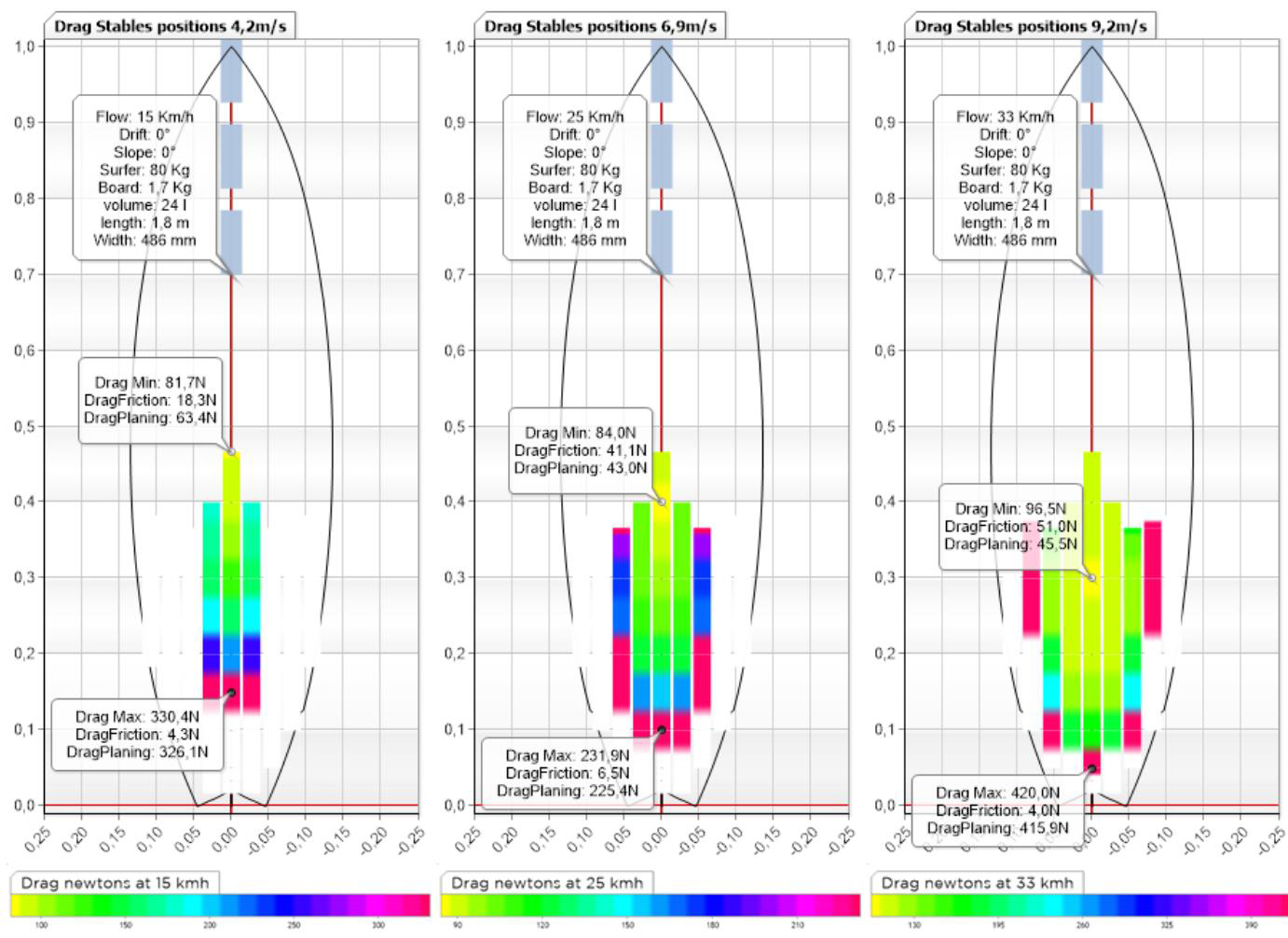
Drag diagram according to the various positions of the surfer (Software ShaperWaveDynamics)
On each diagram, two positions are remarkable: the maximum drag position (drag max) and the minimum drag position (drag min). Bubbles indicate the drag and its distribution in friction and planing for these remarkable positions. The maximum drag position tells us the maximum braking force the surfer can generate. The minimum drag position tells us the minimum drag force, and therefore the optimal position for picking up speed. It is essential for the comprehension of the hydrodynamics of surfing, to note that the optimal position of minimum drag varies according to the speed: This optimal position, of treated minimum, moves back with the speed. In this example, it goes from 0.46, to 0.4 and 0.3 respectively, at speeds of 15, 25 and 33 km/h. This comes from the fact that drag is composed of 2 types of drag: friction drag, and shape drag, which evolve differently depending on speed. The surfer will benefit from moving back, to reduce the friction surface at high speed, and increase the angle of incidence to obtain the best compromise. We will therefore be attentive to the fact that the optimal position of the surfer varies according to the speed.
The hydrodynamic drag diagram, shows how the forces of friction and form resistance (or planing) combine according to the angles of incidence and the relative speed of the surfer, in the position of generation of minimum drag on his board:
Example of variation in drag and planing angle as a function of speed (Software ShaperWaveDynamics)
the curve with the silhouettes of surfers represents the variation of the planing angle in degrees which decreases with the speed as well as the planing speed or displacement of the surfer. the black curve shows the accumulation of friction drag (gray triangle curve) and planing drag (gray squares). 3 markers (blue vertical lines) show the 1, 2 and 3 m crest wave speeds. The red horizontal line shows the average rowing strength of an athletic surfer. This graph is valid for a given surfer weight (here 80 kg), a given slope (here 0°), a given board length, shape and volume.
Recall that the hydrodynamic drag force represents the resistance to progress at a given speed. If at 5 km/h, the drag force is 130 newtons, the surfer will have to find a propulsive force of 130 newtons to maintain this speed. If the propulsive force is greater, the surfer accelerates. If the propulsive force is less than the drag, the surfer loses speed, he brakes. To understand this rule is to understand the engine of the surfer.
What we learn from this graph is, for example, the paddling speed that a surfer can reach producing 100 newtons of thrust when paddling: this is the place where the drag curve intersects the red line of thrust of 100 newtons: 4 kph. We also see that at this speed the surfer is still immersed (mention "sink") and does not take advantage of enough planing force to reduce his submerged volume, he therefore generates a lot of resistance to progress. Planing reaches 100% around 9 km/h with an angle of incidence of 22°. It is from this moment that the drag curve begins to descend, giving the surfer a better glide.
We have seen that the surfer needs propulsive force to maintain or increase his speed. It has several sources for this: the oar, gravity, flotation, a sail or any other tractor such as a jet ski or a propeller for example. It is enough to know the propulsive forces and the resistance forces to know if the surfer accelerates or brakes. Gravity generates a vertical force that provides no propulsion on a horizontal surface. But when the slope of the surface on which the surfer floats, or hovers, increases, a propulsive force is produced. It's the surfer's gravity motor, and it's by far the most powerful and exhilarating to use.
Remarquez que l'on a employé deux termes différent pour la portance: Flotter et Planer sur la surface en pente. Dans un cas, c'est la force de flottaison qui porte le surfer, et dans l'autre c'est la force de planing.
- The buoyancy force, is produced by the volume of water displaced, buoyancy is perpendicular to the surface: on a still water surface it is vertical, but on a sloping wave surface it is perpendicular to the surface. slope!) and acts even without the speed of the surfer, The buoyancy force can be exerted without speed, we call it Hydrostatic lift:
- The planing lift force is produced by the speed and the angle of attack of the wet surface of the board (surface in contact with the water) there is no planing without speed and without angle of incidence. and you will have guessed the name of the planing force, related to speed: hydrodynamic lift. A method for calculating the hydrodynamic lift of the surf is proposed in the chapter surf calculation method
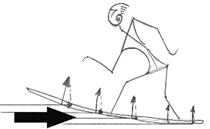 hydrodynamic lift, planing force
hydrodynamic lift, planing force
Hydrostatic lift, buoyancy force
If we show the propulsive force in our drag graph, under a 10 degree slope, we get:
the blue propulsive force curve (triangle points), meets the black drag curve at 6 km/h, this means that the 10 degree slope propels the surfer at 6 km/h, but to go faster it will take more slope or more thrust. If we add to the blue curve the force of 100 newtons of rowing we could pass the peak of resistance at 250 newtons and fly towards planing and high speeds. In other words, this board is surfable at 10 degrees of slope for this surfer if he has the paddling force of 100 newtons, on the other hand if he can only produce 50 newtons of thrust when paddling, this board will not allow him not to start on a 10 degree slope, he will have to wait for it to form more, here is the same board at 20 degrees of slope:
At 20 degrees the propulsive force no longer meets any limit, and we observe a surplus of thrust which tightens the acceleration. Unfortunately the surfer who could produce 100 newtons of paddle, is already on the wave from its 10 degrees, it will be necessary to wait for the next wave or to do push-ups, or to choose a board with more buoyancy volume, which will produce more thrust at 10 degrees!
The "ShaperWaveDynamics" (SWD) software offers an analysis function that collects data for each slope angle. we can thus deduce the minimum take off slope for a surfer and a given board on a wave of given height and period. The study of the take off thus makes it possible to precisely choose the volume and the size of a board according to the surfer and the wave which he wishes to surf, by using the concept of minimum slope of take off. See: Contions and analysis of take off in surfing See: Contions and analysis of take off in surfing
- The Lateral Stability and Maneuverability Diagram ,shows how the lateral displacement modifies the roll angle (and consequently the radius of curvature of trajectory see: surf turn and surf roll trajectories) The roll moment indicates the force which it is necessary to apply to put roll angle. The higher the moment, the harder it is to carve the board.

Example of stability diagram for a board 2.26 m long and 589 mm wide, at 9.16 and 20 km/h with an 80 kg surfer. the vertical axis represents roll in degrees. The horizontal axis represents the displacement of the surfer's center of support laterally, zero is at the center of the board and the right end of the horizontal axis is at the rail. The unstable zone, where the support position causes the board to turn over, is represented by a gray vertical band. The stability zone is 252 mm wide at 9 km/h, it covers the entire width at 16 km/h and returns to 250 mm at 20 km/h. The interest of this type of diagram is at the level of maneuverability analysis. The larger the stability width, the more stable the board. These figures do not speak too much at first sight, but a comparison of two volume configurations of similar boards in terms of shape at the same speed, clearly indicates the variation in effort to be produced to put the board on a given roll angle.
The trajectory curve radius that defines the turn is the result of the balance of centrifugal forces and projected lift forces along the roll angle. See surf turn
The diagrams seen above are constructed by positioning, for each speed, the surfer's center of support at the distance from the tail generating the minimum drag. A map of the drag values according to the positions for each speed has therefore been established beforehand:
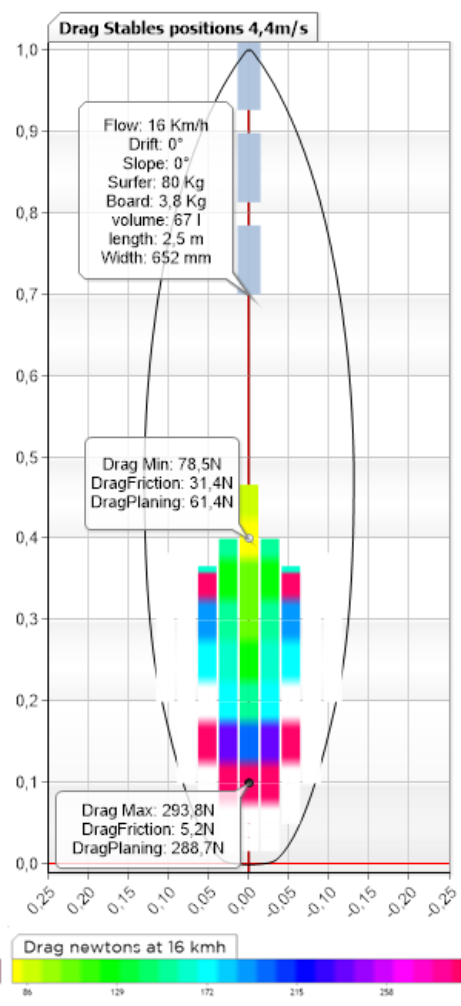
hydroscan positioning the minimum drag at 16 km/h, this optimal position changes with speed.
These analysis tools being briefly described, we can use them to compare the variations in performance from one surfer weight to another, for a board to check if it is suitable for the surfer
- in terms of manoeuvrability: See surf maneuverability
- in terms of take off ability: see take off analysis
